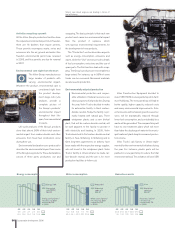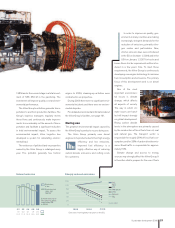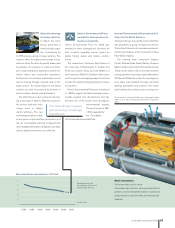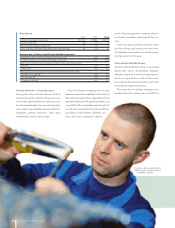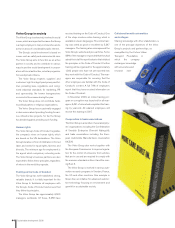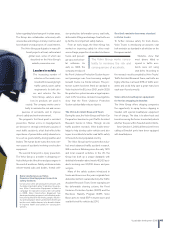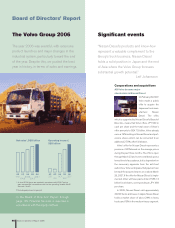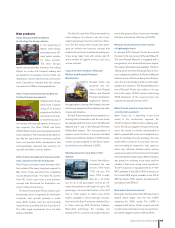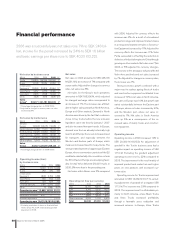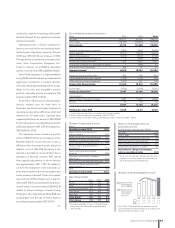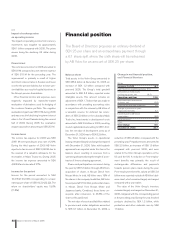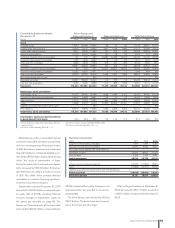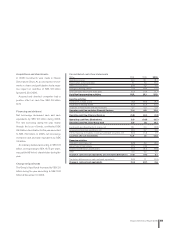Volvo 2006 Annual Report Download - page 49
Download and view the complete annual report
Please find page 49 of the 2006 Volvo annual report below. You can navigate through the pages in the report by either clicking on the pages listed below, or by using the keyword search tool below to find specific information within the annual report.
tutes regarding future transport in urban areas.
The Group also collaborates extensively with
universities and colleges in many countries and
has initiated several projects of social interest.
The Volvo Group participates in many dif-
ferent projects at local, national and
global level, some of which are
described on the Volvo Group’s
website, www.volvo.com.
Leaders in safety
The increasing number of
vehicles on the roads, com-
bined with increasingly high
traffic speeds, raises safety
requirements for both driv-
ers and vehicles. For the
Volvo Group, safety is about
how its products are used in
society. The company works consis-
tently to minimize the risk and conse-
quences of accidents, and to improve
drivers’ safety and work environment.
The program’s first focal point is accident
prevention. Human errors or misjudgements
are decisive or strongly contributory causes of
most traffic accidents, a fact that reflects the
importance of preventative safety characteris-
tics such as good visibility, driving qualities and
brakes. The human factor is also the most com-
mon cause of accidents involving construction
equipment.
The second focal point is injury prevention.
The Volvo Group is a leader in designing ve-
hicles that protect the driver and passengers in
the event of a collision. Safety solutions include
rollover-tested cabs and bodies, frontal colli-
sion protection, deformation zones, seat belts,
deformable fittings and airbags. Seat belts are
by far the most important safety feature.
From an early stage, the Volvo Group has
worked on improving safety for other road-
users. A large proportion of accidents between
trucks and passen-
ger cars involve fron-
tal collisions. As
early as 1996, the
company introduced
the Front Underrun Protection System to pre-
vent passenger cars from becoming wedged
beneath trucks in a frontal collision. This pro-
tection system has been fitted as standard to
Volvo trucks in the EU since 2001, and in 2003
the protection system became a legal require-
ment in EU countries. Accident investigations
show that the Front Underrun Protection
System substantially reduces injuries.
The Volvo Accident Research Team
During the year, the Volvo Group and Volvo Car
Corporation launched a joint Traffic Accident
Research Center in China. Through on-site
traffic accident research, Volvo builds know-
ledge to help develop safer vehicles and also
hopes to contribute to better road traffic safety
in the world’s most populated country.
The Volvo Group has the automotive indus-
try’s most advanced traffic accident research.
With a center in Göteborg since the early 1970
and local research activities in the US, the
Group has built up a unique databank with
detailed information about nearly 40,000 acci-
dents involving over 50,000 drivers and pas-
sengers.
Many of the safety systems introduced in
trucks and buses over the years originate from
data collected from real accidents by the Traffic
Accident Research Team. Some examples are
the deformable steering column, the Front
Underrun Protection System (FUPS) and the
Electronic Stability Program (ESP). Volvo
Buses aims to install ESP in tourist buses and
seat belts in all its vehicles by 2010.
Seat belt reminder becomes standard
in Volvo trucks
To further increase safety for truck drivers,
Volvo Trucks is introducing an acoustic seat
belt reminder as standard in all vehicles on the
European market.
Statistics show that
most drivers killed or
injured in traffic acci-
dents were not using
seat belts. According to
the research results compiled by Volvo Trucks’
Traffic Accident Research Team, seat belts are
highly effective in at least 60% of traffic acci-
dents and could help save a great many lives
each year if used correctly.
Volvo offers breathalyzer equipment
for ferries stopping in Sweden
The Volvo Group offers shipping companies
the opportunity to equip ferries stopping in
Sweden with special breathalyzer equipment
free of charge. The idea is to allow truck and
bus drivers using the ferries to voluntarily check
whether they are within Swedish alcohol limits.
Since October 1, 2006, all Stena Line ferries
calling at Swedish ports have been equipped
with breathalyzers.
Safer workplaces as Volvo
Construction Equipment invests in
safety helmets
Construction sites are among the worksites with
the highest accident rates. To address this prob-
lem, Volvo Construction Equipment initiated a
campaign for improved construction site safety
in 2006. Volvo Construction Equipment has
developed a safety program in which safety prob-
lems are tackled at three levels: people, machin-
ery and workplace. Volvo’s protective helmets will
be the most visible element of a broad initiative
to improve health and safety for construction
workers.
The Volvo Group works consis-
tently to minimise the risk and
consequences of accidents.
Sustainable development 2006 45



